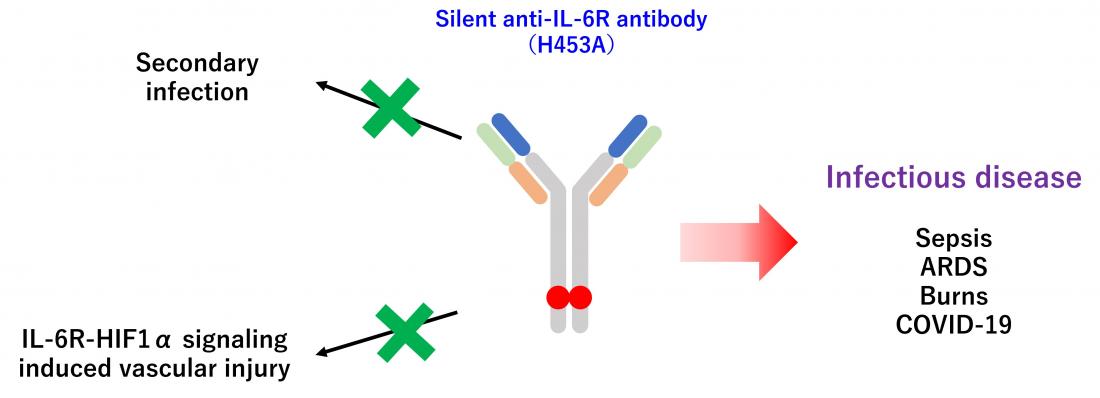Giving medication a short half-life anti-IL-6 to patients of Sepsis, ARD, Burns, etc. is expected to suppress vascular damage or secondary infection.
Researchers from Osaka University discover a novel treatment strategy for cytokine storm, a serious inflammatory syndrome triggered by an infection or severe burn
Osaka, Japan – Cytokines are chemical messengers that help the body get rid of invading bacteria and viruses, and control inflammation. The body carefully balances cytokines because they help keep the immune system healthy. However, this balance is upset if the immune system overreacts. A serious infection or a severe burn can unleash a cytokine storm in the body. During the storm—also called cytokine release syndrome (CRS)—the body produces too many cytokines, leading to life-threatening inflammation.
Interleukin-6 (IL-6) is a key cytokine in the storm because it helps to drive the inflammation that damages the body. IL-6 delivers its message by fastening to IL-6 receptors within cells, which tells the cells to spread inflammation. Because IL-6 is important in CRS, treatments that block the IL-6 signal can relieve inflammation. However, this blocking tends to be long-lasting, which leads to side effects.
In a study published this month in the Proceedings of the National Academy of Sciences (PNAS), researchers from Osaka University have discovered a way to block IL-6 signals while minimizing treatment side effects. The group interrupted the inflammatory signal using an antibody that blocks the IL-6 receptor for only a short time. The brief interruption was long enough to protect the tissues against injury from cytokine storms caused by sepsis or severe burns.
“Our results suggest that CRS can be treated with an IL-6 receptor antibody that has a short half-life,” says the study's lead author Sujin Kang. “This can prevent vascular damage and at the same time reduce the side effects associated with blocking IL-6.”
Vascular damage happens when an infection or burn causes the cells that line the inner surface of blood vessels to become leaky. The leaking fluid triggers a cytokine storm and can cause a secondary infection. The group also reported a potential mechanism for this damage to cells. When IL-6 binds to its receptor it activates a protein called hypoxia-inducible factor-1α (HIF1α), which amplifies inflammation.
“We found that blocking the IL-6R–HIF1α signal strengthened vascular endothelial cells and improved vessel integrity. This helped to prevent leakage from the vessels and relieved the inflammation caused by CRS,” explains senior author Tadamitsu Kishimoto. “We hope this will help patients suffering from CRS and other inflammatory diseases in the future.”
Other diseases that can cause CRS include sepsis and acute respiratory distress syndrome, COVID-19 infection, and ischemia. People with traumatic injuries and those taking some cancer immunotherapies can also experience a cytokine storm. The findings of this study can hopefully provide an alternative therapeutic approach to patients with these conditions.
###
The article, “Gp130–HIF1α axis–induced vascular damage is prevented by the short-term inhibition of IL-6 receptor signaling,” was published in the Proceedings of the National Academy of Sciences (PNAS) at DOI: https://doi.org/10.1073/pnas.2315898120
About Osaka University
Osaka University was founded in 1931 as one of the seven imperial universities of Japan and is now one of Japan's leading comprehensive universities with a broad disciplinary spectrum. This strength is coupled with a singular drive for innovation that extends throughout the scientific process, from fundamental research to the creation of applied technology with positive economic impacts. Its commitment to innovation has been recognized in Japan and around the world, being named Japan's most innovative university in 2015 (Reuters 2015 Top 100) and one of the most innovative institutions in the world in 2017 (Innovative Universities and the Nature Index Innovation 2017). Now, Osaka University is leveraging its role as a Designated National University Corporation selected by the Ministry of Education, Culture, Sports, Science and Technology to contribute to innovation for human welfare, sustainable development of society, and social transformation.
Website: https://resou.osaka-u.ac.jp/en
About Immunology Frontier Research Center (IFReC), Osaka University
IFReC was established by the support of the World Premier International Research Center Initiative (WPI) in 2007. IFReC aims to overcome immune-related diseases by clarifying the whole picture of the immune system, and has promoted globally competitive fundamental research with excellent researchers from overseas.
Website: https://www.ifrec.osaka-u.ac.jp/en/



